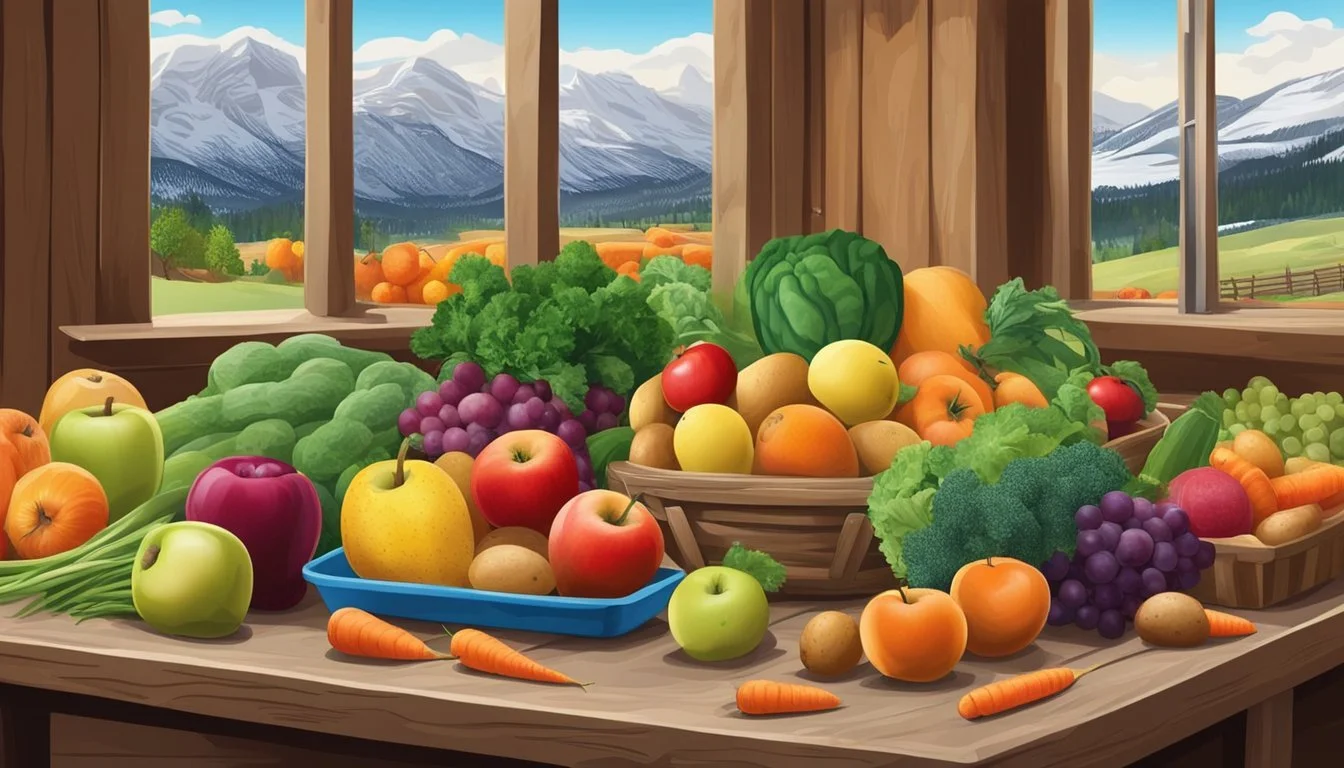Wyoming Seasonal Fruit & Vegetables in January
Your Fresh Guide
This Article is Part of our Wyoming Seasonal Fruit & Veg Calendar
Wyoming's agricultural bounty in January may not be as diverse as in the warmer months, but there is still a variety of seasonal produce available. Despite the harsh winter conditions, farmers and gardeners manage to cultivate and harvest hearty vegetables that can withstand the cold. Root vegetables and sturdy greens are typical in this season, offering both nutrition and flavor for winter dishes. Eating seasonally during this time supports local agriculture and provides the freshest ingredients for hearty, nutritious meals.
Seasonal produce in Wyoming during January includes an array of cruciferous vegetables like kale and broccoli (how long does broccoli last?), as well as other nutrient-dense options such as cauliflower and romanesco. These vegetables are not only robust enough to survive the winter chill but are also versatile in the kitchen, pairing well with a variety of flavors. Citrus fruits, transported from warmer climates, also make their appearance in Wyoming markets during this time, providing a burst of freshness and vitamin C that is especially welcome in the depth of winter.
Understanding Seasonality in Wyoming
In Wyoming, the availability of seasonal produce is significantly influenced by its unique climate and the farming practices adapted to it.
Climate and Weather Impact
Wyoming's climate plays a crucial role in determining the seasonal availability of fruits and vegetables. January's weather is typically cold, with frequent snow, limiting the types of produce that can grow during this time. Local seasonal produce is generally restricted to cold-hardy vegetables and stored harvest from prior months.
The state's growing season is relatively short due to its high elevation and cold temperatures, which leads to a limited variety of produce in the winter.
Root vegetables and cruciferous vegetables like sweet potatoes, carrots, broccoli, and Brussels sprouts (how long do brussels sprouts last?) are more likely to be available because of their ability to withstand cooler temperatures.
Local Farming Practices
Local farmers in Wyoming have adapted their practices to optimize the growth of produce within the constraints of the region's weather patterns.
Techniques such as the use of greenhouses or indoor growing systems can extend the growing capabilities for certain crops beyond the typical outdoor growing season.
Season extension methods and the storage of produce harvested during peak seasons ensure a supply of certain vegetables during the off-season months.
By understanding both the impact of Wyoming's climate and the adaptive farming practices, consumers can better anticipate the availability of seasonal produce in January.
Seasonal Fruits Available
Wyoming's winter month of January, despite its chilling temperatures, offers a modest variety of fruits that are ripe and rich in essential nutrients like vitamin C, which is vital during this cold period.
Citrus Fruits
Citrus fruits thrive in colder months, and January is prime time for grapefruits and navel oranges. These fruits, celebrated for their high vitamin C content, are both ripe and ready for consumption.
Grapefruit: Known for its juicy, tangy flavor and health benefits.
Navel Oranges: Seedless and perfect for a fresh, vitamin-packed snack.
Root Vegetable Derived Fruits
Though traditionally not a peak season for fruits, root vegetable storage capabilities allow for certain types of fruit-like produce to be available.
Pomegranate: Technically a berry from a deciduous shrub, pomegranates are still available in January, mostly due to their long storage life.
Cold Storage Fruits
Through the use of cold storage, apples and pears, harvested in late summer and autumn, remain available and in good condition during January.
Apples: A variety of apples remain crisp and sweet when stored properly.
Pears: Different types of pears retain their texture and flavor in cold storage.
Seasonal Vegetables and Their Benefits
January in Wyoming offers a range of vegetables that are not only hardy enough to withstand the chill but also provide robust health benefits. These include an assortment of root vegetables, leafy greens, and cruciferous vegetables, each group offering distinctive nutrients and advantages for health.
Root Vegetables
Root vegetables thrive in cooler temperatures, making them a stable harvest during Wyoming's January climate. Key examples include:
Potatoes: A good source of potassium and fiber, potatoes can help in maintaining healthy blood pressure levels.
Turnips: High in antioxidants and fiber, turnips may aid in digestive health and cancer prevention.
Beets: Known for their rich content of folate and manganese, beets are beneficial for a healthy heart and liver function.
Carrots: Providing high levels of beta-carotene, which the body converts to vitamin A, carrots support eye health and immune function.
Parsnips: These contain vitamins and minerals, such as vitamin C and folate, and have a sweet, earthy flavor.
Leafy Greens
Leafy greens are nutritionally dense vegetables that offer a variety of health benefits:
Kale: It is rich in vitamins A, C, and K, and its fibrous content supports a healthy digestive tract.
Collards: A traditional leafy green that is a great source of calcium and can support bone health.
Cruciferous Vegetables
Cruciferous vegetables are well-known for their potential in cancer prevention and are packed with nutrients despite the frigid weather:
Broccoli: Offers high levels of vitamin C and is also rich in fiber, supporting both the immune system and digestion.
Cauliflower: While not green, it's a versatile vegetable that's rich in vitamin C and can be a low-carb substitute for grains and legumes.
Brussels Sprouts: They contain high amounts of vitamin K and antioxidants known to reduce inflammation and promote heart health.
Kohlrabi: This lesser-known vegetable is high in fiber, which is beneficial for maintaining a healthy gut.
Tips for Selecting and Storing Produce
When selecting and storing seasonal fruits and vegetables in Wyoming, it's important for the consumer to focus on ripeness for the best taste and to apply proper storage techniques to extend the food's freshness.
Choosing Ripe Produce
One should assess the produce's color, firmness, and fragrance. For instance, ripe fruits often have a vibrant color and may give off a sweet aroma. Vegetables, on the other hand, should have a firm texture without any soft spots or discoloration. A simple pressure test can often reveal if the item is ripe; the produce should yield slightly to pressure, but not be too soft or mushy.
Proper Storage Techniques
The longevity of produce can be significantly influenced by storage conditions. Follow these guidelines for optimal storage:
Temperature: Fruits and vegetables should be kept at temperatures just above freezing (32°F) to slow down decay. Specific varieties may have particular temperature preferences.
Humidity: Many refrigerators come with humidity drawers; use them to set the right level for delicate items like leafy greens or herbs.
Avoid Ethylene Producers: Some fruits, like apples, emit ethylene gas which can accelerate ripening and spoilage of nearby produce. Store them separately.
Air Circulation: Ensure the produce has enough space for air to circulate, preventing mold growth and uneven ripening.
By understanding ripeness indicators and implementing strategic storage techniques, one can enhance the taste and longevity of Wyoming's seasonal fruits and vegetables.
Healthy Eating with Seasonal Produce
January in Wyoming offers a unique range of seasonal fruits and vegetables that can enhance one's diet both nutritionally and in flavor. These produce items are typically at their nutritional peak, possessing a richer taste and more potent health benefits.
Nutritional Benefits
Seasonal vegetables available in January such as kale and broccoli are dark green powerhouses packed with vitamins, minerals, and antioxidants. They offer an ample supply of Vitamin C and are rich in fiber, which is crucial for digestive health. Consuming these vegetables can strengthen the immune system, especially during the colder months.
Fruits like oranges and lemons are not only flavorful but also loaded with Vitamin C and antioxidants, contributing to immune defense and skin health. These light green to yellow-hued fruits also provide a burst of fiber. They represent the kind of food that can be easily integrated into a daily diet to maintain overall health.
Recipe Ideas
Stews and Soups: Incorporate kale, leeks, and other root vegetables into hearty stews. These dishes are not only warming but also provide a high content of nutrients and fiber.
Citrus-Infused Dishes: Add freshly squeezed orange or lemon juice to enliven recipes, which infuses a fresh taste and vitamin boost. For instance, pairing citrus with roasted vegetables offers a refreshing flavor contrast and ups the antioxidant content.
Utilizing food such as fresh greens and citrus fruits in recipes not only brings out the best in taste but also capitalizes on their health-promoting properties. It's a beneficial approach for anyone looking to maintain a healthy diet through the winter season.
Supporting Local Agriculture
In the New Year, there's a growing emphasis on bolstering local economies and encouraging sustainable practices by supporting local farmers in Wyoming. This push not only helps to keep the state's agricultural roots strong but also provides consumers with fresh, high-quality produce.
Benefits of Buying Local
Local Expertise: Wyoming farmers have a deep understanding of the state's unique climate and soil, allowing them to grow produce that's well-suited to local conditions. They often offer heirloom and specialty varieties not found in larger grocery chains.
Freshness and Flavor: Produce purchased locally is typically fresher, having been harvested at peak ripeness. This translates into superior flavor and nutritional content.
Economic Support: Money spent on local produce stays within the community, supporting local families and bolstering the state’s economy.
Environmental Impact: Local produce requires less transportation, which reduces carbon emissions and helps to protect Wyoming's natural landscape.
Finding Local Farmers Markets
Seasonal Availability: During January and other winter months, Wyoming's farmers markets adapt by offering goods that are available despite the cold, such as stored root vegetables or greenhouse-grown items. Some also provide non-perishable products like honey, jams, and pickled vegetables. (What wine goes well with pickled vegetables?)
Resources: The Wyoming Specialty Crop Directory is an accessible resource for consumers seeking local produce and products throughout the state. It contains nearly 800 listings of local food producers.
Community Events: Farmers markets often serve as community hubs, where one can find not only produce but also local crafts, recipes tailored to the available produce, and sometimes even gardening tips from the growers themselves.
While fresh fruits may be scarce in Wyoming in January, buying local is a practice that supports the state's agricultural heritage and contributes to a robust local food system year-round.
Seasonal Challenges and Considerations
In January, Wyoming gardeners face significant obstacles due to the harsh weather conditions, which limit the variety of local produce and increase reliance on out-of-state fruits and vegetables to maintain a diverse diet.
Dealing with Limited Variety
In the depths of Wyoming's frigid January, local gardeners face the stark reality of weather's impact on produce variety. The cold climate restricts growth to mainly storage crops and hardy winter varieties. Fresh local produce is scarce, leading to a narrowed selection for consumers. Root vegetables such as beets, carrots, and turnips may still be available from late season harvests but are not plentiful.
Influence of Out-of-State Produce
Wyoming's demand for fresh produce in January is often met by states blessed with milder winters, such as California, Florida, and Texas, where crops can be grown year-round. Citrus from Florida, leafy greens from California, and root vegetables from Maine or New York often appear in local markets. This out-of-state produce is vital to maintaining a varied diet when local gardens are dormant.








